Ireland’s first school of medicine
Published in Early Modern History (1500–1700), Features, Issue 4 (July/August 2011), Volume 19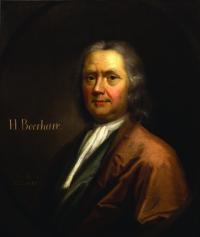
Herman Boerhaave (1668–1738), professor of physic at the University of Leiden, revolutionised the teaching of medicine. Boerhaave was both a scientist and a physician. During his tenure at Leiden, from 1701 until 1738, some 735 English-speaking students attended the medical school, although its popularity did not survive his death. Boerhaave’s major achievement, which made Leiden’s medical school the best in Europe, was his reconstruction of the curriculum. It departed from tradition by beginning with the preliminary sciences—in particular chemistry and botany—as a foundation. These were followed by anatomy and physiology, then pathology and therapeutics, and finally clinical medicine. This pattern of teaching medicine was sound and continued for centuries. (Royal College of Physicians of London)
Prior to the eighteenth century Ireland’s physicians had trained in Europe—in France, Belgium, Italy, Holland or England. When medicine became well established in Scotland, many Irish medical students, especially those from Ulster, went there.
Leiden
The teaching of medicine in seventeenth-century Europe had followed developments in science, and the University of Leiden in Holland had become a centre of these developments. It was here that the impetus for change began. Herman Boerhaave (1668–1738), a leading exponent of the application of physics to medicine, became its professor of physic and revolutionised the teaching of medicine.
Boerhaave had originally intended to become a Protestant minister and entered the University of Leiden in 1684 at the age of sixteen to study philosophy, metaphysics and ethics, with Greek, Latin, chronology and geography. He also studied Hebrew. After graduating, he undertook some mathematical teaching and was employed for a time at the university library.
It was then suggested that he might study medicine, and between 1691 and 1693 he concentrated on medical studies—largely self-taught and by studying acknowledged medical writers. He was a particular admirer of the works of Newton, Harvey and Sydenham. He also studied anatomy and dissected animals. His own two major works were the Institutiones Medicae (1708) on the theory of medicine, which ran through ten editions and was translated into five languages, and the Aphorisms, which dealt with the practice of physic.
In 1702 Boerhaave was appointed as a university lecturer in medicine, and later, when various professorships fell vacant, he was elected to them also—initially as professor of medicine and subsequently to the chairs of botany and chemistry. He finally became rector magnifico of the university.
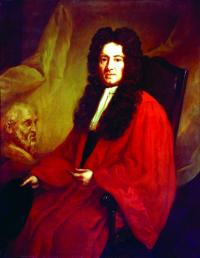
John Stearne (1624–69), elected public professor of medicine in Trinity College for life in 1656. In 1667 he secured a charter from Charles II for the College of Physicians in Dublin. (Royal College of Physicians of Ireland)
Trinity College and the College of Physicians in Dublin
Trinity College, founded in 1592 by letters patent from Queen Elizabeth I, was the only university in Ireland and was strong in classical education. Its professors were all unmarried and lived in college. By the 1650s the senior academic staff consisted of the provost, seventeen fellows and a regius professor of physic who was a physician rather than a cleric or a classical scholar. It had no medical school.
In the mid-seventeenth century, senior physicians in Dublin were anxious to improve their status with initiatives that developed over a 50-year period. In the 1650s there was a desire among the physicians to form themselves into a college along the lines of the Royal College of Physicians in London and to found a medical school at Trinity. The Fraternity of Physicians—which later received a charter as the ‘King and Queen’s College of Physicians in Ireland’—was established in 1654. The fraternity was based in Trinity Hall, a building originally intended as a bridewell or house of correction—‘a place of punishment for offenders and for putting idle persons to work’. It had been given to the university in 1615 and was used as a student residence until 1641. In 1665 it was leased to John Stearne, the leading Irish physician of the day, by the provost and fellows of Trinity on the understanding that he would endeavour to secure a royal charter for it. It was used for the study of physic and no students could be admitted to it unlessthey had first enrolled in Trinity College. In 1656 Stearne was elected public professor of medicine in Trinity College for life.
Stearne died in 1669, having achieved his aim. In 1667 the college had been inaugurated as the College of Physicians in Dublin with a charter from Charles II. In 1692 William and Mary granted a new charter to entrust to the now Royal College the supervision of apothecaries, surgeons and midwives as well asphysicians inDublin and for seven miles around it.
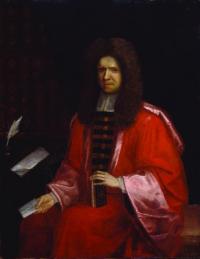
Sir Patrick Dun (1642–1713), elected president of the College of Physicians in Dublin in 1681 and again in 1688. Originally from Aberdeen, he left his considerable fortune for the establishment of a chair of physic at Trinity College and a teaching hospital. (Royal College of Physicians of Ireland)
Medical education was progressing. The study of surgery, as distinct from its practice, was seen as a legitimate part of medicine. New scientific thinking had led, among other things, to Harvey’s discovery of the circulation of blood. The need for an autopsy to find out the cause of death and make a correct diagnosis, albeit post mortem, was becoming a feature of medicine. Physicians needed to learn about the human body, and the teaching and training of doctors required change. A medical school was essential for all of this to happen and would be modelled on the practice and curriculum that had been devised and directed by Boerhaave in Leiden.
Foundation of medical school
The founding of the medical school at Trinity occurred when money to appointfurther professors in Dublin was short. Trinity College was fortunate, as several physicians, including John Stearne and subsequently Patrick Dun, were wealthy and generous. Dun came originally from Aberdeen, where he had qualified before coming to Dublin. He was elected president of the College of Physicians in Dublin in 1681and again in 1688, and was appointed physician-general to the army in Ireland in 1705 at a fee of ten shillings a day. He wasalso a member of the Irish parliament from 1692 to 1695. In 1694 he married Mary Jephson, who was wealthy in her own right. In 1711 he made a will leaving money for the establishment of a chair of physic in the university and a teaching hospital where clinical instruction could be given to students. Because of wrangles between the College of Physicians and the university it was nearly 100 years before his wishes were finally carried out with a new hospital bearing his name. Dun died in 1713 aged 71.
On 14 June 1710, the provost and senior fellows had ordered ground to be laid out in the south-east corner of the physic garden—previously a kitchen garden—to erect a laboratory and an anatomical theatre. The building was to be two storeys high and made of birch. Inside, a chemistry lab and lecture room were planned.
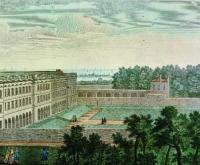
A 1753 print by Tudor of Trinity’s Old Library. The original medical school is the two-storey building at the end of the colonnade to the right of the picture. (Trinity College, Dublin)
There was also to be a dissecting room and a museum, although there was no running water or drainage. At the opening ceremony DrHelsham gave a lecture on natural philosophy, which was a synonym for physics until the twentieth century. He continued to lecture unofficially, and without pay, from 1711 until 1724, when he was appointed as the first professor of natural and experimental philosophy, a position he held until his death in 1738. His lectures were published posthumously by his successor in the chair, who had been a student of his. These went into eight editions in the next 100 years. At the inauguration of the medical school another lecture on anatomy was given by Dr Hoyle. Thomas Molyneux, Dr Robert Griffiths and Dr Thompson also spoke.
Henry Nicholson, another graduate of Leiden, was the first professor of botany. He was in charge of the physic garden that had been initiated on the main college campus in 1687 and was by 1711 well established to provide plant material to support the teaching of medicine. Nicholson wrote the first botanical treatise published in Ireland, which was essentially a 40-page catalogue of the garden. His successor, William Stephens, had studied at Glasgow and Leiden and was in charge of Trinity’s second physic garden, established behind the anatomy theatre.
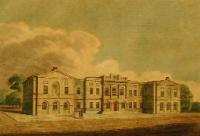
Nineteenth-century print of Sir Patrick Dun’s Hospital. Because of wrangles between the College of Physicians and Trinity College it was nearly 100 years before Dun’s wishes were finally carried out with a new hospital bearing his name. The first stone was laid in 1803.
The medical school developed slowly and the number of medical degrees awarded remained small. Depending on previous experience gained at other European medical schools, such as Leiden, it was possible for a student to obtain a medical degree in two years and thus to become a licentiate of the College of Physicians. Students with no previous training would take eight years to graduate. The first degrees awarded by Trinity were MB or MD, since neither surgery nor obstetrics were taught.
Uneasy relationship
For many years the relationship between the College of Physicians and the medical school was uneasy. There was a complex set of regulations for obtaining a degree and students were required to alternate between the two institutions, with various documents and fees involved. The number of candidates prepared to negotiate all this was low. A dispute between the two bodies also inhibited the establishment of the clinical lectures envisaged by Sir Patrick Dun. These difficulties were eventually solved by a new School of Physic Act in 1800, which provided for a payment of £100 each to two new king’s professors of medicine. It also stipulated that a teaching hospital, where clinical instruction could be given to students, should be built with the surplus of Sir Patrick Dun’s estate. There was a long delay before all this could be carried out, and it was only in 1803 that the first stone of the new hospital was laid.
From a very small and difficult start the medical school has slowly developed into a major institution with a worldwide reputation. The school curriculum barely changed from its inception in 1711 until the middle of the twentieth century. It followed the school of Boerhaave, starting with scientific studies and ending with clinical ones. Today, as Trinity medical school prepares to enter its fourth century, undergraduate teaching in medicine and the initial qualification from the university is only the beginning of the journey, and further postgraduate training is needed for a successful medical career. But Stearne, Dun and Molyneux—the pioneers—provided a worthy start. HI
Dame Beulah Bewley is Emeritus Reader in Public Health Sciences at the University of London.
Further reading:
J. Fleetwood, History of medicine in Ireland (Dublin, 1951).
J.P.C. Kirkpatrick, History of the medical school in Trinity College, Dublin (Dublin, 1912).
















